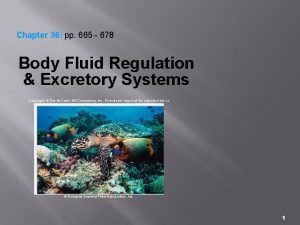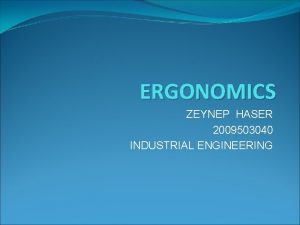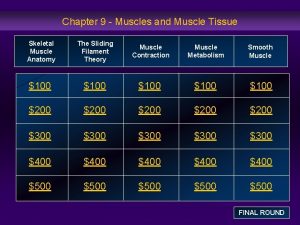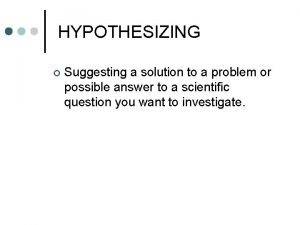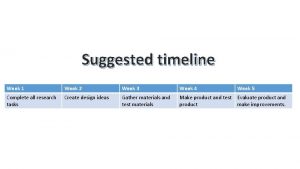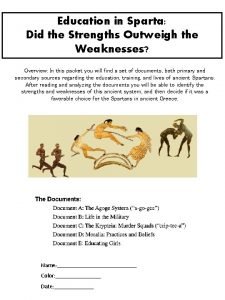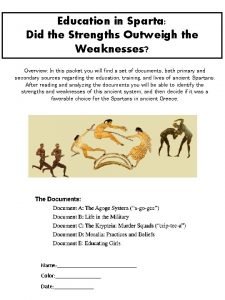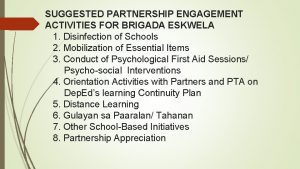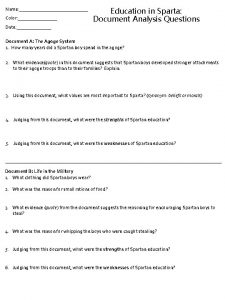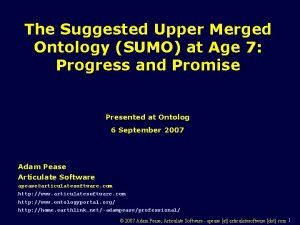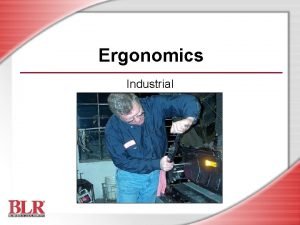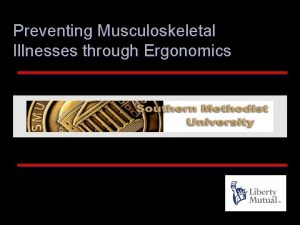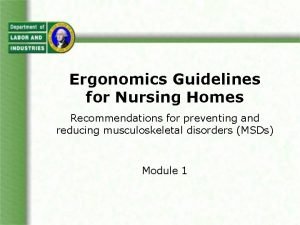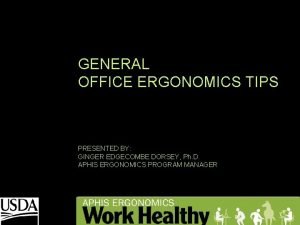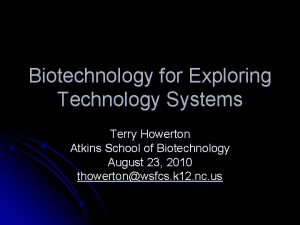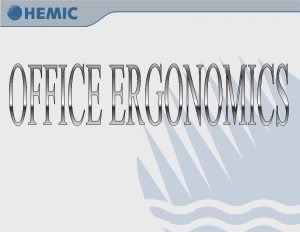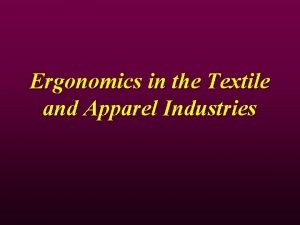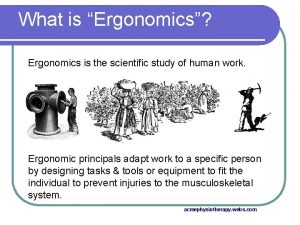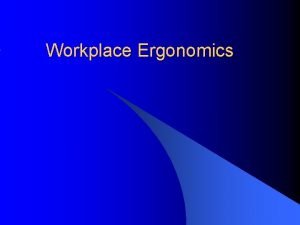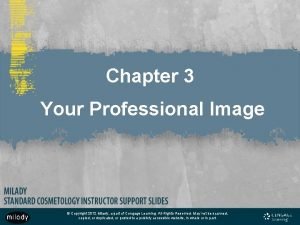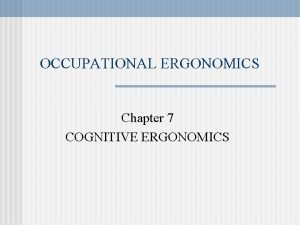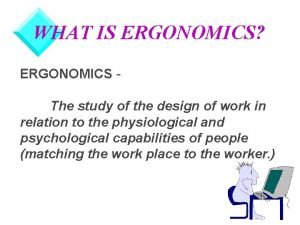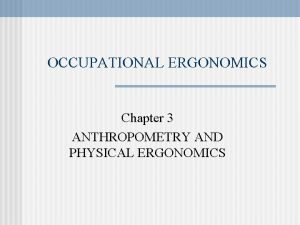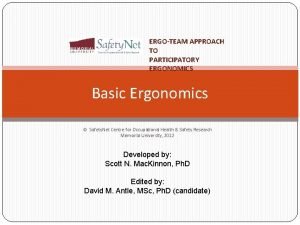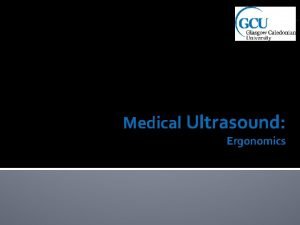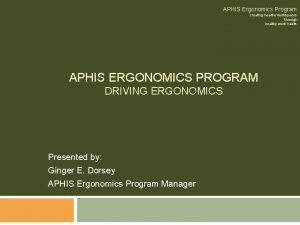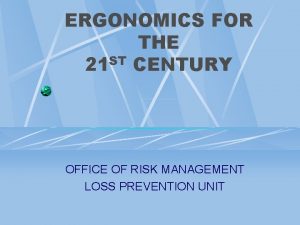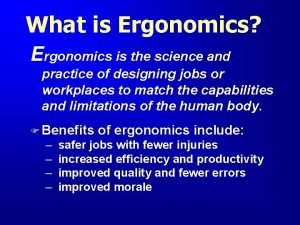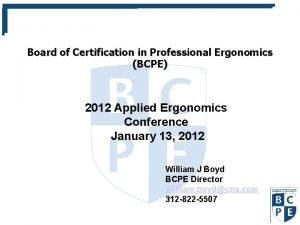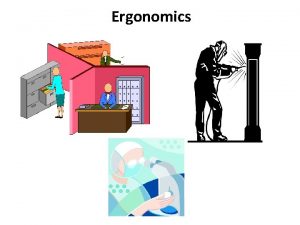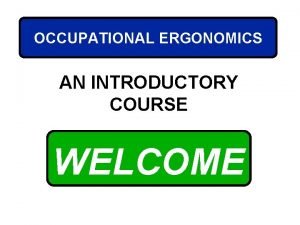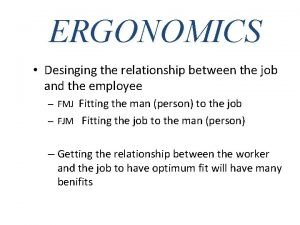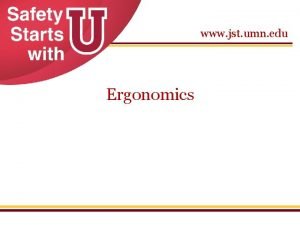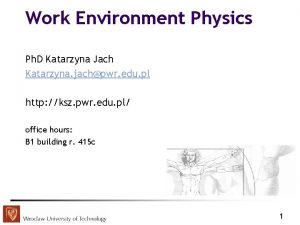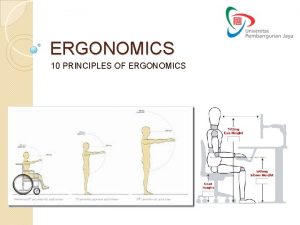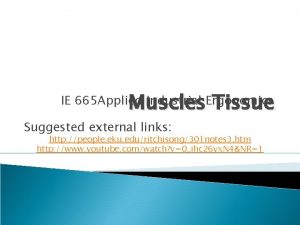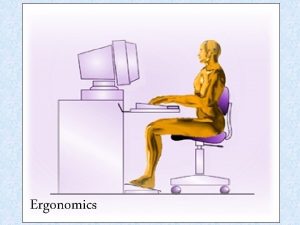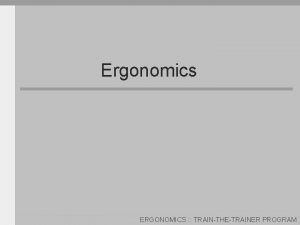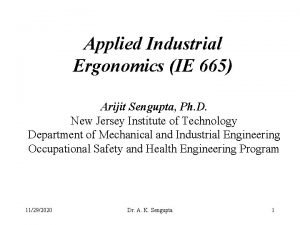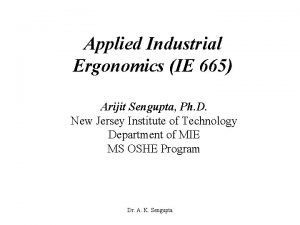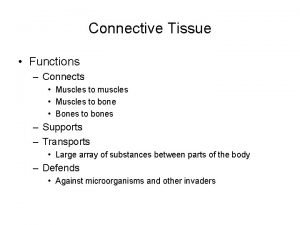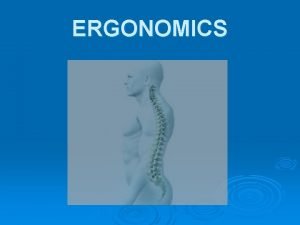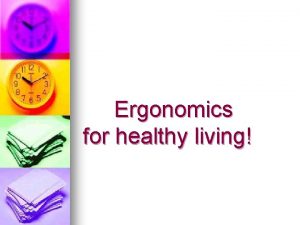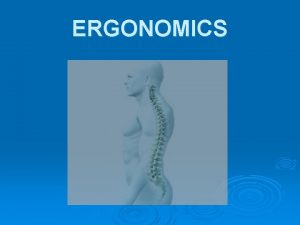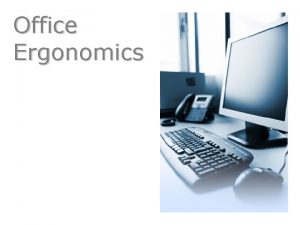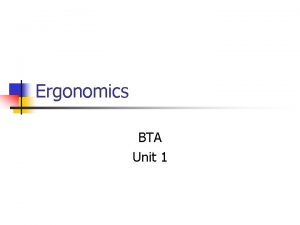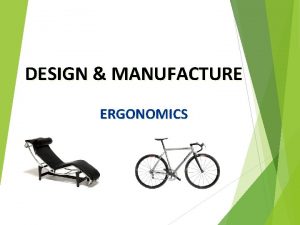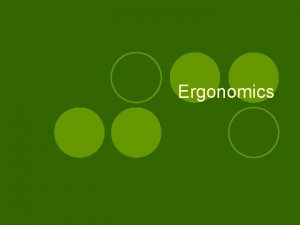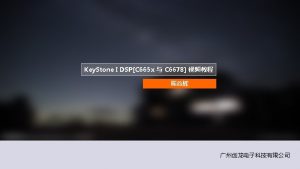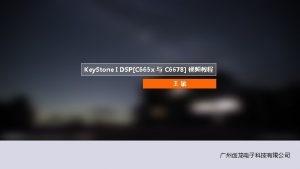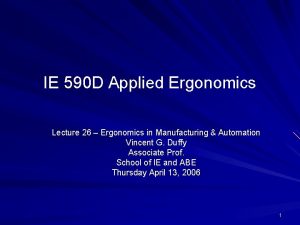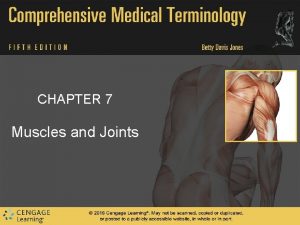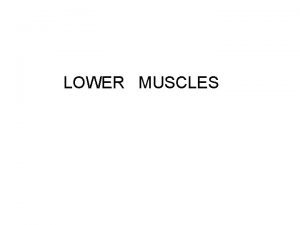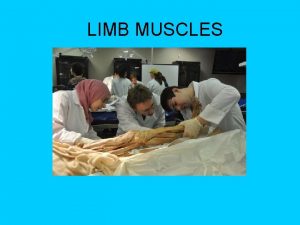Muscles Tissue IE 665 Applied Industrial Ergonomics Suggested
















































- Slides: 48

Muscles Tissue IE 665 Applied Industrial Ergonomics Suggested external links: http: //people. eku. edu/ritchisong/301 notes 3. htm http: //www. youtube. com/watch? v=0_ihc 26 yx. N 4&NR=1

Topics to be covered � Three types of muscle tissues: Skeletal, Smooth and Cardiac. � Some basic functions and fundamental characteristics of skeletal muscles. � Function and Structure of skeletal muscle tissue � The nerve tissue and motor unit � Microscopic anatomy of a skeletal muscle tissue How a muscle tissue contracts Action potential Length tension characteristics of a muscle tissue � Force regulation in skeletal muscles � How energy is metabolized for muscle contraction and cellular respiration � Fatigue in static and dynamic muscular work

Types of muscle tissues

Three types of muscle tissue • Skeletal muscle attaches to bones, holds the skeleton against gravitational forces & moves skeleton to produce motion • Smooth muscles are present in the walls of blood vessels, intestine & other 'hollow' organs. Its rhythmic contraction moves body fluids. • Cardiac muscle are present in the wall of the heart. Its rhythmic contraction moves blood. FOCUS OF THIS COURSE IS THE SKELETAL MUSCLES

Skeletal muscle tissue • It is under voluntary control. The muscle can be contracted and relaxed at will. • It has a striated appearance under microscope, which is due to the orderly arrangement of the contractile proteins within the tissue. • The cells are cylindrical and multinucleated. Striations Nuclei

Smooth muscle tissue • Involuntary muscle, ie. , not under voluntary control • Not striated under microscope • Not multinucleated

Cardiac muscle tissue • Involuntary, ie. , not under voluntary control • Striated appearance under microscope • Auto rhythmic, ie. contracts rhythmically without any nervous impulse (nerve impulse modifies the rhythm) • Not multinucleated • Rectangular in shape

Functions of muscle tissue • Produces motion – fundamental characteristics of all living things • Produces force (tension) • Maintains posture – works against gravitational forces • Provides joint stability • Produces heat as a bi-product of contraction

Characteristics of muscle tissue • Excitability - responds to stimuli (e. g. , nervous and other impulses) • Contractility - able to shorten in length • Extensibility - stretches when pulled • Elasticity - tends to return to original shape & length after contraction or extension

Physical Structure of Skeletal Muscle � � � Each skeletal muscle spans over one or more skeletal joints and the muscle contraction produces a force that tends to turn a bone about its joint axis. Skeletal muscles vary in size, shape, and arrangement of fibers. They range from extremely tiny strands such as the stapedium muscle of the middle ear to large masses such as the muscles of the thigh. A gross muscle contains skeletal muscle tissues, connective tissues, nerve tissues, and vascular (blood circulation) tissues. Out of these, only the muscle tissue has the contractile property.

Connective Tissues in Skeletal Muscle Each muscle is surrounded by a connective tissue sheath called the epimysium. Fascia, connective tissue outside the epimysium, surrounds and separates the muscles. Portions of the epimysium project inward to divide the muscle into compartments. Each compartment contains a bundle of muscle fibers. Each bundle is called a fasciculus and is surrounded by a layer of connective tissue called the perimysium. Within the fasciculus, each individual muscle cell, called a muscle fiber, is surrounded by connective tissue called the endomysium. All these connective tissue fuse together at the two end and forms tendon, which connects muscles to bones

Role of Connective Tissues in Skeletal Muscle � Skeletal muscle cells (fibers), like other body cells, are soft and fragile. The connective tissue covering furnish support and protection for the delicate cells and allow them to withstand the forces of contraction. � Through these tough tissues contractile force of the muscle cells are transmitted to the bone. � The coverings also provide pathways for the passage of blood vessels and nerves.

Vascularization of Skeletal Muscle � Skeletal muscles have an abundant supply of blood vessels, approximately 2 capillaries per muscle cell. Capillaries supply the essential oxygen and nutrients to each muscle fiber. � Since the capillaries spreads evenly in the muscle body the smaller muscles cells have more capillaries.

Tendons and Ligaments The connective tissues, the epimysium, perimysium, and endomysium extend beyond the fleshy part of the muscle to form a thick ropelike tendon or a broad, flat sheet like aponeurosis. The tendon form attachments from muscles to the bones and aponeurosis forms connection to the connective tissue of other muscles. Typically a muscle spans a joint and is attached to bones by tendons at both ends. One of the bones remains relatively fixed or stable while the other end moves as a result of muscle contraction. Ligaments forms joint capsules are fibrous tissues that connect bone to bone.

Nervous System functions � It is the major controlling, regulatory, and communicating system in the body. If muscles are power house, then the nerves are the control mechanism. � It is the center of all mental activity including thought, learning, and memory. � Together with the endocrine system (producing hormones), the nervous system is responsible for regulating and maintaining homeostasis (regulates internal environment so as to maintain a stable, constant condition). � Through its receptors, the nervous system keeps us in touch with our environment, both external and internal.

Nervous System � The nervous system is composed of central nervous system (brain and spinal chord) and peripheral nervous system (containing nerve cells external to the brain or spinal cord). � These, in turn, consist of various tissues, including nerve, blood, and connective tissue.

How Nervous System Works � � Millions of sensory receptors detect changes, called stimuli, which occur inside and outside the body. They monitor such things as temperature, light, and sound from the external environment. Inside the body, the internal environment, receptors detect variations in pressure, p. H, carbon dioxide concentration, and the levels of various electrolytes. All of this gathered information is called sensory input (afferent nervous system). Sensory input is converted into electrical signals called nerve impulses that are transmitted to the brain. There the signals are brought together to create sensations, to produce thoughts, or to add to memory; Decisions are made each moment based on the sensory input. This is integration. Based on the sensory input and integration, the nervous system responds by sending signals to muscles, causing them to contract, or to glands, causing them to produce secretions. The nerve cells that send impulse to muscle cells are called motor nerve (efferent nervous system).

Typical motor (neurons) nerves and motor unit � � Axon terminals of one motor neuron innervate a number of muscle cells that are dispersed randomly in the overall muscle mass. The muscle cells and the single motor neuron that innervates them make one motor unit. When the neuron of a motor unit sends a nerve impulse which exceeds a threshold value, all the muscle cells (fibers) of the motor unit contract together. All or none principle Number of muscle cells controlled by a motor neuron varies. Muscles which require fine controls may have innervations of a few muscle cells per motor neuron, where as, when gross force production is the primary objective, motor units innvervates large (over hundred) number of muscles cells.

Innervation of muscle cells � When the nerve impulse (electrical) reaches axon end, the permeability of the synaptic vesicle membranes at its axon ends releases chemical neurotransmitter (acetylcholine). � This chemical binds with the muscle cell membrane molecules at the synaptic cleft (known as motor end plate), and stimulates the muscle cell.

Microscopic Structure of a Muscle Cell Neucleus Sarcolema Mitochondria Contractile proteins Sarcolemma: Bi layer lipid membrane, semi permeable, has specialized molecules that selectively control inflow and outflow of ions from the extra cellular space. Motochondria: Organelle, where ATP (Adenosine Tri phosphate) is synthesized by oxidative process. ATP is only form of energy that muscle cells can utilize to produce mechanical energy. Contractile proteins: Responsible for muscle contraction.

T-tubules and Sarcoplasmic reticulum

Arrangement of Protein filaments Muscles cells are packed with myofibrils. Myofibrils are composed of two main types of myo filaments: thick and thin. They are arranged in a very regular, precise pattern. Myosin – thick filaments Actin – thin filaments Sliding of the thin filaments over the thick filaments causes sarcomere to contract. Sarcommere: The smallest contractile unit.

Models of Protein filaments

Review – U-tube video � http: //www. youtube. com/watch? v=Ed. Hz. KYD xr. Kc&feature=player_embedded

Resting potential of sarcolemma � � In a resting muscle, there is a higher concentration of Na+ ions in the extra cellular space and a higher concentration of K+ ions in the intracellular space (inside the muscle cell membrane). In resting state the muscle cell membrane remains electrically polarized (i. e. outside has higher positive ion concentration than inside). This is due to the fact that K+ ions are small and can freely defuse across the cell membrane but larger Na+ ions cannot, which makes the cell membrane polarized.

Single Action Potential: Initiation of muscle contraction � � � Nerve impulse (electrical) reaches the axon end of the nerve cell. The Impulse releases a neurotransmitter chemical (acetylcholine) that binds with specific molecules at the motor end plate Due to this chemical reaction, some molecules at the motor end plate change their shapes opening gates (pores) for Na+ ions start to diffuse in the muscle cell. The influx of Na+ ions locally depolarizes the cell membrane. After the depolarization reaches a threshold level, a local electric current sets up between the depolarized region at motor end plate and the neighboring polarized (resting) regions of the cell membrane. This electric current opens more voltage sensitive Na gates on the cell membrane and causes Na+ ions influx in the neighboring region of the cell membrane. This newly depolarized region, in turn, depolarizes their neighboring region and the depolarization wave propagates in the outward direction from the motor end plate, and travels the entire length of the muscle cell. This phenomena is called Action Potential.

Action potential: Continued � � � The wave also reaches the deep inside of the cell body trough the t tubules. This whole phenomena starts with a single nerve stimulus that exceeds a threshold level. Once a single nerve stimulus level exceeds a threshold value, the action potential starts with the same intensity (all or none principal). Larger discharge of neurotransmitter would not produce stronger Action potential. Right after the depolarization, acetylcholine is broken down by enzymes and Na+ ions are actively (using energy molecules) transported back to the outside of cell membrane and the cell membrane returns to its normal polarized (resting) state.

Conversion of chemical to mechanical energy Action potential reaches deep in the muscle through the T tubules, which causes release of Ca+2 ions. �Ca+2 ions binds with tropomyosin protien, and shifts the troponin molecules to open the binding site of actin and myosin. �Myosin molecule attaches to actin molecule and change its shape, and sliding the actin molecule. �With the presence of energy molecule (ATP), myosin combines with ATP, and the mysin actin bond is broken. �As long as ATP and Ca+2 ions are present, this process continues. �If no new nerve impulse is there, then Ca+2 ions are actively pushed back in to SR, and binding sites of actin myosin are closed and the sliding stops. �

Conversion of chemical to mechanical energy (continued) WATCH HOW MUSCLE CELLS CONTRACT �http: //www. youtube. com/watch? v=g. J 309 Lf. HQ 3 M&feature =player_embedded#! �http: //www. mmi. mcgill. ca/mmimediasampler/

Muscle Twitch- tension from a single action potential The muscle twitch is a single response to a single stimulus. Latent period the period of a few ms for the chemical and physical events preceding actual contraction. Contraction period tension increases (myosin cross bridges are swiveling) Relaxation period – muscle relaxes, relieves tension or comes back to its original length. Since it occurs due to passive tension from the connective tissues, takes more time than the contraction phase.

Graded Contraction We do not use the muscle twitch as part of our normal muscle responses. Instead we use graded contractions, contractions of whole muscles which can vary in terms of their strength and degree of contraction. In fact, even relaxed muscles are constantly being stimulated to produce muscle tone, the minimal graded contraction possible. Muscles exhibit graded contractions in two ways: (1) Motor Unit Summation/Recruitment/Quantal Summation: Increasing numbers of motor units to increase the force of contraction. (Quantal, because individual muscle cells cannot be recruited). (2) Wave Summation/Rate coding & Titanization: This results from stimulating a muscle cell before it has relaxed from a previous stimulus by increasing the frequncy of nerve stimulation. This is possible because the contraction and relaxation phases are much longer than the refractory period.

Quantal Summation/Recruitment

Frequency Summation or Rate coding

Isometric and Isotonic Contractons

Length-Tension Relationship Another way in which the tension of a muscle fiber can vary is due to the length tension relationship. Muscle fibers along with its connective tissues are elastic, i. e. , muscle fibers can be elastically stretched by the action of external forces. For example, as we flex our elbow, the length of the biceps muscle fibers shortens. Opposite happens when the elbow is extended. With the change of length of a muscle fiber from its resting or optimum length, the number of cross bridges between actin and myosin filaments decreases. As a result of this, the force developed for an action potential decreases as it is stretched or shortened from its normal resting length.

Length-Tension Relationship Force developed due to sliding action of protein filaments. Force The graph shows the force developed in a muscle fiber for a single twitch, when it is kept at various lengths. Lo is the normal resting length of the muscle fiber. The black line shows the contractile force generated by the action of myosin sliding over actin filaments. After sufficient stretch, the elastic contractile force from the connective tissues adds a passive tension. Force due to stretching of connective tissues Lo Length Lo = Normal resting length of the muscle

Energy consideration for muscle contraction Muscle contraction needs energy for myosin actin sliding, transport of Na out of plasma membrane, transport of Ca molecules back to SR etc. all of which are energy intensive. Muscle cells, like all other cells, use ATP (adinosine tri phosphate) as their energy currency. ATP↔ADP + Energy Each muscle cell stores some ATP, which can sustain contraction for 1 to 2 seconds. To continue contraction, other high energy particles are broken down and the energy liberated from these reactions is used to re synthesize ADP back to ATP to sustain contraction.

Stored Energy: CP Muscle cells store a high energy molecule, Creatine Phosphate, which can be readily decomposed to Creatine and phosphate to liberate energy, which then can be used to re synthesize ADP to ATP. But this source of ATP can only supply a cell for 8 to 10 seconds during the most strenuous exercise. Creatine phosphate can be stored and is made from ATP during periods of rest.

Glycolysis The bulk of the energy supply comes from metabolism (destruction) of glucose molecules, which is stored as glycogen (polymer of glucose) in muscle cells. Fat ( and protein in extreme cases) molecules, supplied through blood are also metabolized in some cases. Glucose molecules can be metabolized in two ways: Anaerobic: In the absence of oxygen (anaerobic glycolysis) – glucose molecules are broken down to pyruvic acid and each molecule produces energy equivalent to 2 ATP molecules. End product of anaerobic glycolysis is Lactic acid, which builds up in muscle cells causing local fatigue painful sensation. Aerobic: In the presence of oxygen (aerobic glycolysis), glucose molecules break down to simpler molecules (CO 2, H 2 O) and thus produces more energy, equivalent to 36 ATP molecules. This process of energy production can continue for long period of time as O 2 can be made available through blood supply.

Anaerobic Glycolysis is the initial way of utilizing glucose in all cells, and is used exclusively by certain cells to provide ATP when insufficient oxygen is available for aerobic metabolism. Glycolysis doesn't produce much ATP in comparison to aerobic metabolism, but it has the advantage that it doesn't require oxygen. In addition, glycolysis occurs in the cytoplasm, not the mitochondria. So it is used by cells which are responsible for quick bursts of speed or strength. Like most chemical reactions, glycolysis slows down as its product, pyruvic acid, builds up. In order to extend glycolysis the pyruvic acid is converted to lactic acid. Lactic acid itself eventually builds up, slowing metabolism and contributing to muscle fatigue. Ultimately the lactic acid must be reconverted to pyruvic acid and metabolized aerobically, either in the muscle cell itself, or in the liver. The oxygen which is "borrowed" by anaerobic glycolysis is called oxygen debt and must be paid back. But mostly it is the amount of oxygen which will be required to metabolize the lactic acid produced.

Strength Training Effect Strength training increases the myofilaments in muscle cells and therefore the number of crossbridge attachments which can form. Training does not increase the number of muscle cells in any real way. (Sometimes a cell will tear and split resulting in two cells when healed). Lactic acid removal by the cardiovascular system improves with training which increases the anaerobic capacity. Even so, the glycolysis-lactic acid system can produce ATP for active muscle cells for only about a minute and a half.

Aerobic Glycolysis Ultimately, the product of glycolysis, pyruvic acid, must be metabolized aerobically. Aerobic metabolism is performed exclusively in the mitochondria. Pyruvic acid is converted to CO 2 and H 2 O and vast majority of ATP. The reactant other than glucose is O 2. Aerobic metabolism is used for endurance activities and has the distinct advantage that it can go on for hours. Training Effect: Aerobic training increases the length of endurance activities by increasing the number of mitochondria in the muscle cells, increasing the availability of enzymes, increasing the number of blood vessels, and increasing the amount of an oxygen storing molecule called myoglobin.

Types of muscle cells Different types of cells perform the differing functions of endurance activities and speed- strength activities. There are three types, red, white, and intermediate. The main differences can be exemplified by looking at red and white fibers and remembering that intermediate fibers have properties of the other two. White Fibers are fast twitch, large diameter, used for speed and strength, fatigable. Depends on the anaerobic energy metabolism, stores glycogen for conversion to glucose, Fewer blood vessels, Little or no myoglobin. Red Fibers are slow twitch, small diameter, used for endurance. Depends on aerobic metabolism. Utilize fats as well as glucose. Little glycogen storage. Many blood vessels, mitochondria and much myoglobin give this muscle its reddish appearance. Intermediate Fibers: sometimes called "fast twitch red", these fibers have faster action but rely more on aerobic metabolism and have more endurance. Most muscles are mixtures of the different types. Muscle fiber types and their relative abundance cannot be varied by training.

Cellular Respiration At the onset of muscular work, energy is supplied primarily from stored high energy particles and from anaerobic glycolysis. This is because circulatory system takes some time to catch up with the higher O 2 demand at the muscle site. CO 2, and Lactic acid are built up (causing change in Ph level) in the muscle site triggering the CNS to initiates actions to increase cellular respiration (CO 2 and O 2 movement in and out of the cells). This is achieved in a combinations of ways (1) Redistribution of blood supply (dilating the arteries near the muscle and constricting arteries in skin and other organs), and (2) by increasing cardiac output and ventilation at lungs to maintain the O 2 at the working muscle site. Heart rate, stroke volume, blood pressure and respiratory rate increase according to the intensity of the muscular work.

Effect of Muscle tension on Cellular Respiration Cellular respiration is affected by constriction of the nearby arteries and blood capillaries by the mechanical force developed by the muscle itself. The blood supply starts to decrease when the muscle contracts with an intensity of 15% of its maximum voluntary contraction (MVC) capacity. The blood supply is completely occluded above 60% of MVC in most of the muscle cells. Reduction of blood supply means reduction of cellular respiration (O 2 supply and CO 2 removal).

Static muscular work An activity which requires muscle to maintain contraction continuously it is called static muscular work. Muscles that are maintaining a static body posture, or holding a hand tool are example of static muscular work. As blood supply is impeded in this kind of muscle work, depending upon the contraction level, majority of the energy may be produced through anaerobic pathway. As a result, metabolite (Lactic acid) accumulates in the muscle cells and local fatigue of the muscles ensues quickly.

Typical endurance limits of skeletal muscles in static muscle contraction % MVC Endurance time for static muscle contractions 100 6 seconds 75 21 seconds 50 1 minute 25 3. 4 minute 15 > 4 minute

Dynamic muscular work In dynamic muscular work muscle contraction is followed by a muscle relaxation. That is static tension interspaced with relaxation. Work with rhythmic movement, such as walking, is an example of this kind. During relaxation phase, the blood supply is restored which washes away the metabolite (waste byproducts) and supplies nutrients and oxygen. As a result, this kind of muscle work can be continued for long time without fatigue. The rhythmic movement also helps venous return of blood and thus is less taxing on heart performance. In dynamic work, maximum intensity of work is determined by the circulatory systems capacity to supply O 2 which is determined by the Maximum heart rate capacity, or by Maximum O 2 (Max VO 2 in L/min) delivering capacity. Fatigue in this kind of work is primarily from the central fatigue, less blood glucose level, etc.
 Opwekking 665 tekst
Opwekking 665 tekst 665 vs 678
665 vs 678 Define ergonomics in industrial engineering
Define ergonomics in industrial engineering Muscles and muscle tissue chapter 9
Muscles and muscle tissue chapter 9 Jaringan epitel dapat ditemukan di
Jaringan epitel dapat ditemukan di A suggested solution to a problem or question
A suggested solution to a problem or question Suggested timeline
Suggested timeline Did the strengths outweigh the weaknesses in sparta
Did the strengths outweigh the weaknesses in sparta What were the strengths of spartan education?
What were the strengths of spartan education? Reported speech in imperative sentence
Reported speech in imperative sentence Activities during brigada
Activities during brigada Jollibee entrepreneur
Jollibee entrepreneur What spartan values are suggested by this document?
What spartan values are suggested by this document? What did mother suggest nina
What did mother suggest nina Suggested upper merged ontology
Suggested upper merged ontology What did mother suggest nina
What did mother suggest nina Objectives of ergonomics
Objectives of ergonomics Ergonomicsl
Ergonomicsl Nursing homes day out an
Nursing homes day out an Office ergonomics
Office ergonomics Types of ergonomics
Types of ergonomics Objectives of ergonomics
Objectives of ergonomics Cms ergonomics
Cms ergonomics Ergonomics in textile industry
Ergonomics in textile industry Good chair
Good chair What is ergonomics
What is ergonomics What are four good personal hygiene habits milady
What are four good personal hygiene habits milady Ergonomic exercises for computer users
Ergonomic exercises for computer users Human information processing model ergonomics
Human information processing model ergonomics What is ergonomics
What is ergonomics Types of ergonomics
Types of ergonomics Ergoteam
Ergoteam Ergonomics ultrasound scanning
Ergonomics ultrasound scanning Driving ergonomics checklist
Driving ergonomics checklist Types of ergonomics
Types of ergonomics Ergonomics bathrooms
Ergonomics bathrooms Ergonomic lifting techniques
Ergonomic lifting techniques What is ergonomics
What is ergonomics Ergonomics tips for computer users
Ergonomics tips for computer users Https://iehf.org/web-design-ergonomics-checklist/
Https://iehf.org/web-design-ergonomics-checklist/ Controller ergonomics
Controller ergonomics Ergo nomic
Ergo nomic Objectives of ergonomics
Objectives of ergonomics Ergonomics definition
Ergonomics definition Umn ergonomics
Umn ergonomics Ergonomics in welding
Ergonomics in welding Ergonomicsl
Ergonomicsl Ergonomics awareness training for supervisors
Ergonomics awareness training for supervisors 10 principles of ergonomics
10 principles of ergonomics

